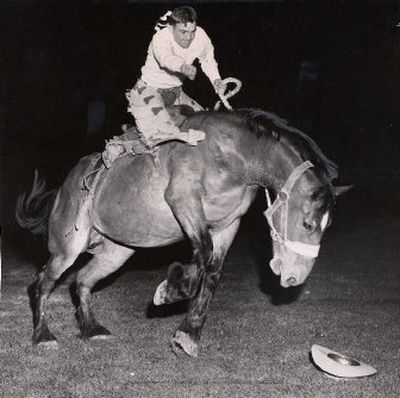Copenhaver pulled big strings

Back in the day, when Deb Copenhaver was putting the Inland Northwest on the rodeo map like Ryan Gray and Rowdy Buechner are now, there was no day like there is now.
As the young bareback riders head off for the National Finals Rodeo in Las Vegas to compete for a Professional Rodeo Cowboys Association championship, they might want to swing by Creston, Wash., and thank the 80-year-old Copenhaver.
Today the NFR is a billion-dollar business and often an extravaganza, especially when everybody gathers in Las Vegas for 10 days of competition in early December.
Gray, from Cheney, has already won $94,417 to sit fourth in the bareback standings, and Buechner, from Sandpoint, has $68,764 and is in 13th place.
Copenhaver was one of the visionaries who made it all possible.
“I was on the RCA Board of Directors in 1958 and in those days they always had a midyear kind of a general meeting of the association,” said Copenhaver, who represented saddle bronc riders. “We met there at Cheyenne and a guy came to us from Dallas, Texas. His name was John Van Cronkhite and he had a presentation for us. You know what it was? It was the National Finals.
“We voted to give him the rights to his idea. That was the beginning of the National Finals.”
The timing was right as Madison Square Garden, then a premier rodeo stop, was relocating and interest in staging rodeos there was waning.
“The new people weren’t interested in promoting a rodeo and so that made us kind of all the more optimistic about trying to put on a big year-end runoff, so to speak, of everyone who qualified,” said Copenhaver.
Before the Finals, champions were the season-long leaders, although there was a long season-ending finale at Madison Square Garden.
“All the races were generally decided back there,” Copenhaver said. “It generally lasted about five or six weeks. We rode about 12 horses. That was a long time. The suspense was really something.
“I was fortunate to win New York twice. The first time was in ‘52 and next time was ‘55. I still ride a saddle I won in New York every day.”
He placed in the top five of the year-long chase five times, finishing runner-up to six-time champion Casey Tibbs three times before winning it all in ‘55.
Copenhaver also won the saddle bronc championship in 1956, but his career was winding down.
“I qualified for the first (Finals) in Dallas in 1959,” Copenhaver said. “That was the last year I rodeoed.”
Tibbs’ last title was at the first Finals, a year when Greenacres bull rider Pete Crump finished 10th, the first of his three Finals appearances.
The NFR, which seem like such an obviously great idea now, wasn’t a slam dunk.
Copenhaver remembers at least one of the eight board members was opposed – calf roping representative Clark McEntire, father of country singing star and actress Reba McEntire.
“At least there were enough of us and that was the beginning,” Copenhaver said.
The plan was to have a season-ending championship in cities that didn’t have major rodeos, rotating every three years. The first stop was Dallas (1959-61), followed by Los Angeles (1962-64).
“After that it went to Oklahoma City and the Okies wouldn’t let it leave,” Copenhaver said.
The Finals moved to Las Vegas in 1985.
By then, Copenhaver, who was born and raised in Wilbur, Wash., but lived in Post Falls while he competed, had long since retired back to the family ranch on Hawk Creek outside Creston. His son, Jeff, made the Finals three times, winning the calf roping championship in 1975 with $34,628 in winnings.
“The most money I ever made was $24,000,” said the elder Copenhaver, who has since moved into Creston and raises quarterhorses. “That was the record for 10 years.”
But the stakes are much higher now, thanks to Van Cronkhite and others like Copenhaver.